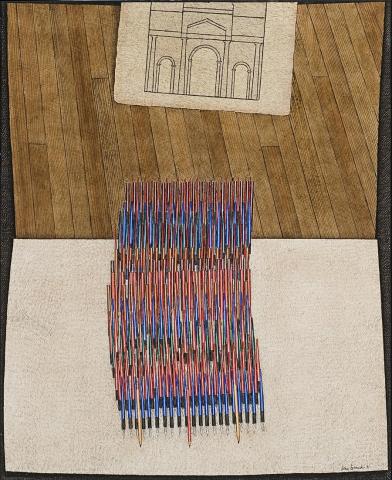TRIUMPHAL MARCH, 1981
JOHN BRACK
watercolour and ink on paper
76.0 x 62.0 cm
signed and dated lower right: John Brack 1981
Tolarno Galleries, Melbourne
Greg Korn collection, Melbourne
Private collection, Melbourne, purchased from the above in 1988–89
Sotheby's, Sydney, 7 May 2007, lot 33
Private collection, Brisbane
John Brack, Tolarno Galleries, Melbourne, 21 May – 11 June 1983, cat. 14
Lindsay, R., et al., John Brack: A Retrospective Exhibition, National Gallery of Victoria, Melbourne, 1987, p. 134
Grishin, S., The Art of John Brack, Oxford University Press, Melbourne, 1990, vol. II, cat. p283, p. 72
Conceived in the same year as John Brack's monumental masterpieceThe Battle, now held in the collection of the National Gallery of Australia, Canberra, Triumphal March may be seen as the logical conclusion to the thematic cycle. As Sasha Grishin notes,'Brack commenced a very deliberate search for a new visual metaphor that would permit him to express the whole complexity of human interconnections.'1 A period of experimentation with other motifs such as walking sticks and umbrellas led Brack to pens and pencils, the implements of his craft. Here Brack had his protagonists with which to enact the grand narrative arcs of conflict; pens and pencils engaged in conquests worthy of the Mycenaean warriors. These are the great chronicles of human civilisation, an endless cycle of destruction, colonisation and rebirth. Of the subject Ted Gott noted,'within this basic genus of conflict, across a decade of creative engagement, Brack's battle composition explored the realms of human interaction and confrontation with permutations and perverse subtleties as endless as the relentless course of history itself.'2
Shown here, the victorious army march in perfect unity, the grand gate or triumphal arch through which they must have just progressed shown in Neo-classical form. Carefully conceived and painstakingly executed, one of the key concerns of Brack's battle paintings was the dehumanisation of the individual once they are subsumed by the mass. The pens and pencils, once tools of an artist's trade, are here transmogrified into a machine of war which marauds, triumphs and collapses in perpetuity.
As observed by Gott, 'Territorial battles and striving for power are constants of human existence, whether it be office politics or world affairs. Brack's many 'battle' compositions also consider the groups which are inexorably connected to the rules of society, as well as the tribal arrangements to which we all unintentionally adhere. Within this overarching view of the world struggle which simultaneously destroys and advances particular branches of civilisations, John Brack's paintings of the 1980s also explore numerous sub-themes such as the ironic duality of society's simultaneous need for and subversion of hierarchical structure... The allegorical reading of many of these pictures is simple enough - We are taken over by Them, and pushed out; but then Them becomes Us, as we realise we are all the same; and this cycle of aggression, colonisation and assimilation is perpetual.'3
1. Grishin, S., The Art of John Brack, Oxford University Press, Melbourne, 1990, vol. I, p. 140
2. Gott, T., A Question of Balance, John Brack 1974-1994, Heide Museum of Modern Art, Victoria, 2000, p. 14
3. Ibid., p. 13
MERRYN SCHRIEVER
